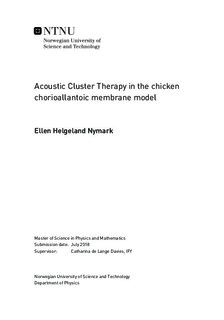Acoustic Cluster Therapy in the chicken chorioallantoic membrane model
Master thesis
Permanent lenke
http://hdl.handle.net/11250/2568874Utgivelsesdato
2018Metadata
Vis full innførselSamlinger
- Institutt for fysikk [2695]
Sammendrag
In this thesis the chicken chorioallantoic membrane (CAM) model was used to study the enhanced delivery of intravenously injected \SI{2}{\mega\dalton} FITC-dextrans using ultrasound in combination with microbubbles. An experimental set-up was established that allows imaging of the treated area during the ultrasound exposure. This makes it possible to study the mechanisms behind the enhanced delivery. Both Sonazoid, a commercial microbubble, and Acoustic Cluster Therapy (ACT), a novel concept improving on some of the shortcomings of the commercial microbubbles, were examined. \textit{In vitro} studies were performed, showing that a co-injection of the dextrans and the microbubbles is possible without significantly affecting the stability and properties of the microbubbles. Cancer cells were inoculated on the CAM to study the effects in tumour tissue. No differences from the effects in normal tissue were observed, and possible explanations for this are discussed. Different events in the treatments with the different bubbles were observed, mainly extravasation of the dextrans and blood spots, and the appearance of bubbles in ACT. Some quantitative analyses were performed, indicating that the extravasations of dextrans are results from various processes caused by the ultrasound and bubbles. It is concluded that the CAM model can be used in further research on the mechanisms behind ACT and ultrasound-mediated drug delivery.
